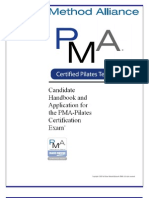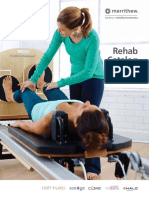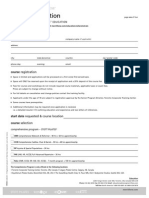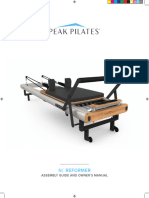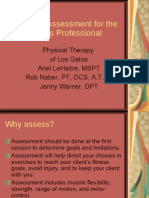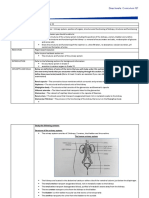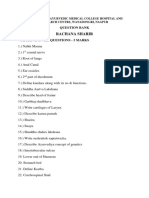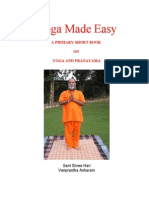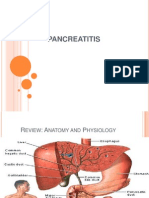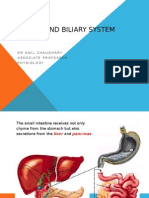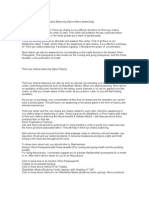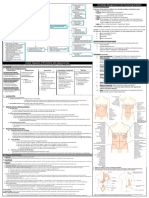0 ratings0% found this document useful (0 votes)
133 viewsPilates For Post-Pregnancy
Pilates For Post-Pregnancy
Uploaded by
Gem Res MésThis document describes a Pilates program designed for a client, Becca, 4 months after giving birth to help address common post-pregnancy issues. Becca's goals were to regain abdominal strength, strengthen her pelvic floor, and improve posture. The instructor created a twice-weekly BASI block program focusing on exercises that avoided forward flexion and abdominal strain due to Becca's mild diastasis recti. The program effectively addressed Becca's goals and provided relaxation benefits in addition to physical improvements. Both the instructor and Becca found the program satisfying and look forward to continuing classes.
Copyright:
© All Rights Reserved
Available Formats
Download as PDF, TXT or read online from Scribd
Pilates For Post-Pregnancy
Pilates For Post-Pregnancy
Uploaded by
Gem Res Més0 ratings0% found this document useful (0 votes)
133 views10 pagesThis document describes a Pilates program designed for a client, Becca, 4 months after giving birth to help address common post-pregnancy issues. Becca's goals were to regain abdominal strength, strengthen her pelvic floor, and improve posture. The instructor created a twice-weekly BASI block program focusing on exercises that avoided forward flexion and abdominal strain due to Becca's mild diastasis recti. The program effectively addressed Becca's goals and provided relaxation benefits in addition to physical improvements. Both the instructor and Becca found the program satisfying and look forward to continuing classes.
Original Description:
Original Title
Pilates_for_Post-Pregnancy
Copyright
© © All Rights Reserved
Available Formats
PDF, TXT or read online from Scribd
Share this document
Did you find this document useful?
Is this content inappropriate?
Report this DocumentThis document describes a Pilates program designed for a client, Becca, 4 months after giving birth to help address common post-pregnancy issues. Becca's goals were to regain abdominal strength, strengthen her pelvic floor, and improve posture. The instructor created a twice-weekly BASI block program focusing on exercises that avoided forward flexion and abdominal strain due to Becca's mild diastasis recti. The program effectively addressed Becca's goals and provided relaxation benefits in addition to physical improvements. Both the instructor and Becca found the program satisfying and look forward to continuing classes.
Copyright:
© All Rights Reserved
Available Formats
Download as PDF, TXT or read online from Scribd
Download as pdf or txt
0 ratings0% found this document useful (0 votes)
133 views10 pagesPilates For Post-Pregnancy
Pilates For Post-Pregnancy
Uploaded by
Gem Res MésThis document describes a Pilates program designed for a client, Becca, 4 months after giving birth to help address common post-pregnancy issues. Becca's goals were to regain abdominal strength, strengthen her pelvic floor, and improve posture. The instructor created a twice-weekly BASI block program focusing on exercises that avoided forward flexion and abdominal strain due to Becca's mild diastasis recti. The program effectively addressed Becca's goals and provided relaxation benefits in addition to physical improvements. Both the instructor and Becca found the program satisfying and look forward to continuing classes.
Copyright:
© All Rights Reserved
Available Formats
Download as PDF, TXT or read online from Scribd
Download as pdf or txt
You are on page 1of 10
‘Pilates
for post pregnancy’
Lizanne Jones
May 26th 2019
Course Location: The Pilates Clinic Wimbledon
ABSTRACT
Throughout the nine months of pregnancy a woman’s body undergoes many
changes, particularly in the final trimester and during the actual delivery itself.
While every woman’s experience of pregnancy will be unique there are many
postpartum imbalances that most women will encounter to some degree – most
commonly these include a weakened pelvic floor, postural changes and
overstretched abdominal muscles. The latter often resulting in Diastasis Recti
also known as abdominal seperation. This is when the linea alba, or connective
tissue that runs down the midline of the abdominals, stretches and causes the
rectus abdominus muscle to separate. Diastasis Recti results in a weakened core
and can cause back pain and compromise pelvic floor function.
My client., Becca, came to me four months after the birth of her second child. Her
primary concern was that she felt her core muscles were weak – I noticed a slight
diastasis recti of a little less than one finger wide. She was also experiencing
some lower back pain and tight, sore upper back and shoulders, probably as a
result of breast feeding and carrying a baby and a toddler (her eldest child was
2).
With all this in mind I was able to devise a programme of twice weekly classes
using the BASI block system.
2
Table of Contents
Title Page
Abstract Page 2
Table of contents Page 3
Anatomical description Page 4
Case Study Page 5
BASI Block Programme Pages 6 & 7
Conclusion Page 8
Bibliography Page 9
3
The diagram above shows what a diastasis recti can look like. To check for
diastasis recti in a client you should do the following:-
1. Lie on back with knees bent
2. Place hands on the abdomen with fingertips extending two inches above and
below the naval
3. Exhale and lift head
4. If you feel a seperation that is greater than two fingers wide a Dr should be
consulted before embarking on any further exercise.
If a diastasis recti is detected, any exercise programme should avoid certain
moves depending on the severity. Whilst observing the utmost caution these
include crunches, hundreds, push ups, planks and oblique work. Pilates provides
a safe and effective way of returning to exercise and rehabilitating the abdominal
muscles not to mention providing a workout for the whole body.
4
Case Study
Clients name: Becca
Age 31
Becca is the mother to a boy and a girl ( aged 2 years 6 months and 4 months).
Becca had not done pilates before coming to me but had done yoga and had very
good body awareness. Becca’s goals were:-
1. Regain abdominal strength
2. Strengthen her pelvic floor
3. Improve posture
Although her Diastasis Recti was not overly pronounced (barely one finger
wide), I decided to initially apply the usual limitations to a programme for a
person presenting with DR ie. No planking, no forward flexion of the upper torso
(sit ups), no upper body flexion with rotation and no extreme back extension.
We agreed that as much as possible to would try to do two classes a week. With
all this in mind I devised the following programme.
5
Becca’s BASI Programme for post pregnancy
Roll down
Mat warm up:-
Pelvic curl
Spine twist supine
Leg lifts
Leg changes
To avoid forward flexion I replaced chest lifts and chest lifts with rotation with
leg lifts and changes. I modified the spine twist supine by keeping knees bent and
feet on the mat.
FOOT WORK – on the Cadillac
Parallel heels
Parallel toes
V position toes
Open V heels
Open V toes
Calf raises
Prances
Single leg heels
Single leg toes
I gave a verbal cue to lift the pelvic floor whilst exhaling and straightening the
legs. Foot work on the Cadillac was a good strong exercise for the hamstrings and
being able to see her feet made any corrections easier to follow.
ABDOMINALS on the reformer
Short box
Flat back and tilt
I made sure there was no flaring of the ribs as the trunk hinged back. The tilt
was a great exercise for the obliques.
HIPWORK on the reformer
Frog
Circles down and up
Openings
SPINAL ARTICULATION on the reformer
Bottom lift
Bottom lift with extension
As well as a nice spinal articulation this also challenged the abs, hamstrings and
hip flexors.
6
STRETCHES on the reformer and ladder barrel
1 Standing lunge
This was a nice hamstring and hip flexor stretch without any strain on the abs
2 Shoulder stretch 1 and 2
This was a great stretch for an area that is often tight after pregnancy and
breastfeeding. Later we also did shoulder stretch on the step barrel which
became a favourite.
FBI 1 on the Cadillac
Side reach
I made sure that her feet were kept pressed firmly on the upright poles to
maintain a stable pelvis. This was a challenging oblique exercise .
ARMWORK on the reformer
Arms sitting series
This was good for arm and upper body strength – very important with the
demands of carrying a baby and a toddler. Strengthening the upper back muscles
helped to improve posture which had been compromised due to hunching over
during breast feeding.
FBI 2 on the Cadillac
Saw
This was a good hamstring stretch and good work for the back extensors which
helped with posture and tension.
LEGWORK on the reformer
Single leg skating
I cued to push into the heel of the foot on the carriage to feel a good glute
challenge.
LATERAL FLEXION/ROTATION on the reformer
mermaid
Later on when the DR was closed I introduced side stretch on the wunda chair.
BACK EXTENSION on the reformer
Pulling straps 1 and 2
We progressed to swan basic on the wunda chair
ROLL DOWN 7
CONCLUSION
This was a very satisfying project for both myself and my client Becca. The BASI
block system, backed up by a bit of reading and research made devising a
programme relatively simple. Having such clear guidelines in the block system
gave me the confidence to teach classes that I knew were safe and effective. A
valuable lesson for me was realizing how important it was for Becca to feel that I
was confident in what I was teaching – motherhood can be a time of stress and
anxiety .
I knew that with dedication and perseverence the programme would deliver
results physically but what I hadn’t counted on was how much it would deliver
over and above that. The breathing patterns and choreography that Becca found
difficult at first became a really important part of the hour, helping her to relax.
The pilates classes continue and we both look forward to them.
8
BIBLIOGRAPHY
Diagram www.mutusystem.com/diasasis-recti
Pilates Second Edition, Rael Isacowitz, 2014
Understanding Diastasis Recti: Part 1 www.bodyandbirth physio.com
Samantha Cattach PT, May 5th 2016
Diastasis Recti:The whole Body solution to Abdominal Weakness and Seperation,
Katy Bowman
Advice on Postnatal Exercise, www.rcob.org.uk
Pilatesanytime.com
9
You might also like
- Reformer 3 PresentationDocument50 pagesReformer 3 PresentationMaría Fernanda Tort Novillo100% (3)
- 01 Pilates Foundation and Mat v202001Document98 pages01 Pilates Foundation and Mat v202001Yulia LarinNo ratings yet
- Assignment - Mat and Foundational Pilates HistoryDocument2 pagesAssignment - Mat and Foundational Pilates HistoryKatelyn SanchezNo ratings yet
- 40 Weeks of Pilates Pilates Through PregnancyDocument17 pages40 Weeks of Pilates Pilates Through PregnancyTatiana Frunze100% (2)
- Reformer Mat2Document55 pagesReformer Mat2Suat Barut100% (1)
- Reformer: and Vertical FrameDocument36 pagesReformer: and Vertical FrameSuchalonelygirlNo ratings yet
- Pilates Class PlanDocument4 pagesPilates Class PlanAlexa Howard50% (2)
- Pilates for Pregnancy: A safe and effective guide for pregnancy and motherhoodFrom EverandPilates for Pregnancy: A safe and effective guide for pregnancy and motherhoodNo ratings yet
- Pilates For HerniationDocument10 pagesPilates For HerniationClaudia Liqui Politi100% (1)
- Pma Cert Booklet and AppDocument11 pagesPma Cert Booklet and AppdiasbarbosaNo ratings yet
- Pilates and PregnancyDocument25 pagesPilates and Pregnancyeubacteria100% (2)
- Reformer Mat3Document66 pagesReformer Mat3Suat Barut100% (5)
- Pilates For Hyperlordosis PDFDocument14 pagesPilates For Hyperlordosis PDFkingawitk100% (1)
- The Benefits of Pilates Exercise in Orthopaedic RehabilitationDocument4 pagesThe Benefits of Pilates Exercise in Orthopaedic RehabilitationLaza CosminNo ratings yet
- PracticalPilates ONLINE 110915Document69 pagesPracticalPilates ONLINE 110915Pia Alesci100% (1)
- Pilates For ScoliosisDocument13 pagesPilates For ScoliosisRevoLutionPilatesNo ratings yet
- Supplemental Exercise ManualDocument64 pagesSupplemental Exercise ManualAnikó Guttmann-Papp100% (2)
- ReformerDocument32 pagesReformerVirginia Lucas33% (6)
- Renin Angiotensin Aldosterone SystemDocument3 pagesRenin Angiotensin Aldosterone SystemDivya Ranasaria100% (1)
- Pilates in The Second Trimester of PregnancyDocument18 pagesPilates in The Second Trimester of PregnancyAmani Trang100% (1)
- Pilates For KyphosisDocument13 pagesPilates For KyphosisAnonymous NKGMQv9100% (1)
- Antenatal Pilates Focusing On The 2nd 3rd TrimestersDocument23 pagesAntenatal Pilates Focusing On The 2nd 3rd TrimestersGursangeet KaurNo ratings yet
- Pilates and PregnancyDocument3 pagesPilates and PregnancyhectornhNo ratings yet
- Mom's Guide to Diastasis Recti: A Program for Preventing and Healing Abdominal Separation Caused by PregnancyFrom EverandMom's Guide to Diastasis Recti: A Program for Preventing and Healing Abdominal Separation Caused by PregnancyNo ratings yet
- The Wall, the Weights and Pre-Pilates ExercisesFrom EverandThe Wall, the Weights and Pre-Pilates ExercisesRating: 5 out of 5 stars5/5 (2)
- 10-Minute Pilates with the Ball: Simple Routines for a Strong, Toned Body – includes exercises for pregnancyFrom Everand10-Minute Pilates with the Ball: Simple Routines for a Strong, Toned Body – includes exercises for pregnancyRating: 4 out of 5 stars4/5 (2)
- Yoga For Pregnancy: Poses, Meditations, and Inspiration for Expectant and New MothersFrom EverandYoga For Pregnancy: Poses, Meditations, and Inspiration for Expectant and New MothersNo ratings yet
- SPX ReformerDocument72 pagesSPX ReformerpereiraNo ratings yet
- A Brochure On The Stott Pilates Five Basic PrinciplesDocument3 pagesA Brochure On The Stott Pilates Five Basic PrinciplesTJS100% (1)
- Rehab Catalog: Intelligent Exercise. Profound ResultsDocument44 pagesRehab Catalog: Intelligent Exercise. Profound Resultseli100% (1)
- Pilates and Pregnancy - ManualDocument47 pagesPilates and Pregnancy - Manualimolagizela-2No ratings yet
- The Benefits of PilatesDocument4 pagesThe Benefits of PilatesJen LeeNo ratings yet
- Owners Manual: Reformer and Deluxe ModelsDocument53 pagesOwners Manual: Reformer and Deluxe ModelsarendaleNo ratings yet
- Pilates Exercises For Pregnant Women PDFDocument5 pagesPilates Exercises For Pregnant Women PDFDevina EkaraniNo ratings yet
- STOTT PILATES Warm Up Spinal Rotation Merrithew®Document1 pageSTOTT PILATES Warm Up Spinal Rotation Merrithew®melinda aniko szaboNo ratings yet
- Pregnancy Course Manual-1Document49 pagesPregnancy Course Manual-1BNo ratings yet
- Pilates and The Powerhouse II PDFDocument9 pagesPilates and The Powerhouse II PDFviboramorNo ratings yet
- Pilates Applied To Scoliosis in A Teenage ClientDocument10 pagesPilates Applied To Scoliosis in A Teenage Clienthappygolucky90No ratings yet
- MPX Reformer With Vertical StandDocument24 pagesMPX Reformer With Vertical StandMaría Fernanda Tort NovilloNo ratings yet
- Pilates TrainingDocument4 pagesPilates TrainingJoshua EreterinoNo ratings yet
- Brent D. Et Al - Introduction To Pilates-Based Rehabilitation PDFDocument8 pagesBrent D. Et Al - Introduction To Pilates-Based Rehabilitation PDFJuliana CarraNo ratings yet
- Module 3 - Pilates Workout - 123129Document5 pagesModule 3 - Pilates Workout - 123129Sheyne CauanNo ratings yet
- Designing A Pilates Program For A Client With Shoulder Impingement SyndromeDocument15 pagesDesigning A Pilates Program For A Client With Shoulder Impingement Syndromebrunoduartefr100% (1)
- GyrotonicsDocument15 pagesGyrotonicsJose Miguel MenciasNo ratings yet
- Pilates Advanced MatworkDocument74 pagesPilates Advanced MatworkPooja Jugdar Deshmukh100% (2)
- Introduction To The NETA Pilates Home Study Certificate Course (PDFDrive)Document178 pagesIntroduction To The NETA Pilates Home Study Certificate Course (PDFDrive)Azaan NavidNo ratings yet
- STOTT PILATES IT Course ApplicationDocument4 pagesSTOTT PILATES IT Course ApplicationVictoria SingerNo ratings yet
- Fit ReformerDocument24 pagesFit ReformercaspadediabloNo ratings yet
- Intermediate MatworkDocument88 pagesIntermediate MatworkGiuseppe Fadda100% (5)
- INTRODUCTIONDocument6 pagesINTRODUCTIONDance For Fitness With PoojaNo ratings yet
- Pilates Assessment 030707Document50 pagesPilates Assessment 030707Shinta HandamariNo ratings yet
- Rehabilitating Sacroiliac Joint Dysfunction With PilatesDocument12 pagesRehabilitating Sacroiliac Joint Dysfunction With PilatesTanya SharmaNo ratings yet
- Group Reformer Checklist Pilates 101Document1 pageGroup Reformer Checklist Pilates 101bodyawarenesseventsNo ratings yet
- Education Teacher Training: PilatesDocument20 pagesEducation Teacher Training: PilatesSylvia Grace100% (2)
- Pilates in Pelvic Floor RehabilitationDocument23 pagesPilates in Pelvic Floor RehabilitationKavya Kavyasujatha100% (2)
- NETA-Intro To Teaching Reformer Pilates-2008Document132 pagesNETA-Intro To Teaching Reformer Pilates-2008Dmitrij Zem100% (1)
- Practical Guide To YogaDocument106 pagesPractical Guide To YogaAnonymous eDyMaC6CNo ratings yet
- Tugas Ekspertise AbdomenDocument42 pagesTugas Ekspertise AbdomentriaclaresiaNo ratings yet
- Body Parts - 2Document13 pagesBody Parts - 2Dede NunuNo ratings yet
- Interrater and Intrarater Reliability of Pressure Biofeedback Unit in Measurement of Transverses Abdominis Muscle Activation in Asymptomatic AdultsDocument7 pagesInterrater and Intrarater Reliability of Pressure Biofeedback Unit in Measurement of Transverses Abdominis Muscle Activation in Asymptomatic AdultsIJAR JOURNALNo ratings yet
- Nakayama ProcedureDocument6 pagesNakayama ProcedureRosyiidta JanahNo ratings yet
- Life Sciences Grade 11 Term 3 Week 5 - 2020Document12 pagesLife Sciences Grade 11 Term 3 Week 5 - 2020YONDELA MbandezeloNo ratings yet
- Wörterbuch Der Humanbiologie - Dictionary of Human Biology - Deutsch - Englisch - Englisch - Deutsch. English - German - German - English (PDFDrive)Document1,002 pagesWörterbuch Der Humanbiologie - Dictionary of Human Biology - Deutsch - Englisch - Englisch - Deutsch. English - German - German - English (PDFDrive)MilaNo ratings yet
- UntitledDocument24 pagesUntitledapi-233604231No ratings yet
- SplenectomyDocument69 pagesSplenectomyAgita GintingNo ratings yet
- AbdomenDocument23 pagesAbdomenjnyamusiNo ratings yet
- Rachana Sharir Question BankDocument5 pagesRachana Sharir Question Bankawnirajgade7No ratings yet
- Outcomes and Mortality of Grade 1 Ascites and Recurrent Ascites in Patients With CirrhosisDocument17 pagesOutcomes and Mortality of Grade 1 Ascites and Recurrent Ascites in Patients With CirrhosisCAMILO FERRERO RESTREPONo ratings yet
- M-Caps-05: Zoology M-Caps-05: Zoology M-Caps-05: Zoology M-Caps-05: Zoology M-Caps-05: ZoologyDocument3 pagesM-Caps-05: Zoology M-Caps-05: Zoology M-Caps-05: Zoology M-Caps-05: Zoology M-Caps-05: ZoologySing GyaniNo ratings yet
- Rekomendasi Antibiotik Pada Profilaksis BedahDocument4 pagesRekomendasi Antibiotik Pada Profilaksis BedahRya At ChinnamorariaNo ratings yet
- The Digestive System and DigestionDocument1 pageThe Digestive System and DigestionTego Shei HarumiNo ratings yet
- Digestive System Part 02Document15 pagesDigestive System Part 02Rehan KhanNo ratings yet
- Yoga Made Easy: A Primary Short Book ON Yoga and PranayamaDocument59 pagesYoga Made Easy: A Primary Short Book ON Yoga and Pranayamasomnathsingh_hydNo ratings yet
- Questions For Doctor NolascoDocument2 pagesQuestions For Doctor NolascodenfanNo ratings yet
- Hepatobiliary Disorders 2Document21 pagesHepatobiliary Disorders 2KatrinaJimenezNo ratings yet
- Chole Lithia Sis Path oDocument6 pagesChole Lithia Sis Path ogeloNo ratings yet
- Lifting Safety ProcedureDocument8 pagesLifting Safety ProcedureZain ul abdinNo ratings yet
- Gi Bleeding CaseDocument28 pagesGi Bleeding CaseP BNo ratings yet
- Liver and Biliary System: DR Anil Chaudhary Associate Professor PhysiologyDocument31 pagesLiver and Biliary System: DR Anil Chaudhary Associate Professor Physiologylion2chNo ratings yet
- 003-Abdominal Wall & Acute AbdomenDocument17 pages003-Abdominal Wall & Acute AbdomenAhmed ZaghwNo ratings yet
- Hpe CPG Abdominal MassDocument54 pagesHpe CPG Abdominal MassAndri wijaya100% (1)
- YogaDocument10 pagesYogaManoj GhureNo ratings yet
- Activity 6 CoronaDocument5 pagesActivity 6 Coronadarkreminder32No ratings yet
- Biliary SecretionDocument29 pagesBiliary Secretionkio josephNo ratings yet
- Acute AbdomenDocument2 pagesAcute AbdomenTroy Feng100% (1)









